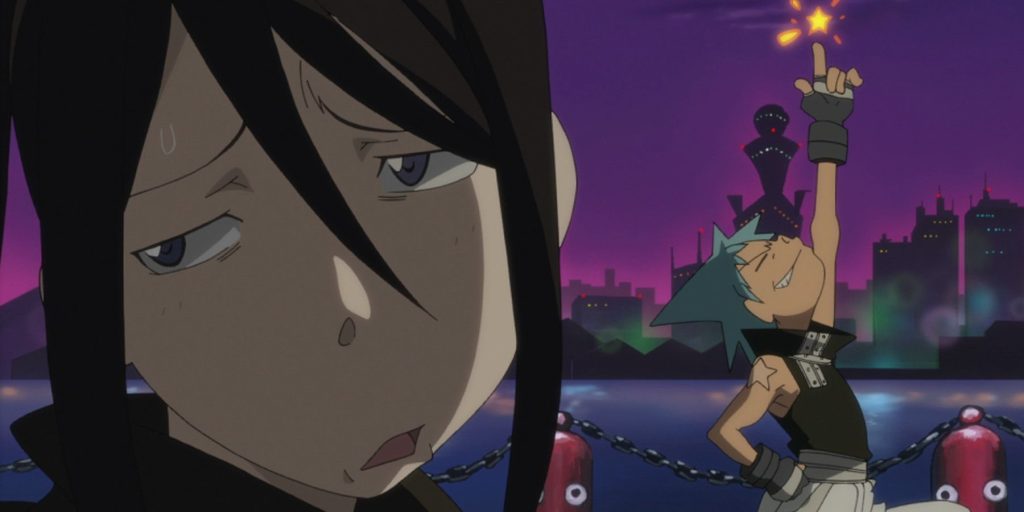Weight gain in anime is often portrayed as a comedic trait among characters. In many anime series, characters gain weight due to overeating or laziness, adding a humorous element to the story.
Weight Gain in Anime can serve as both a comedic element and a way to convey character development.
While some characters remain overweight throughout the series, others may lose the weight through hard work and determination, showing the audience the character’s growth and self-improvement.
Additionally, weight gain in anime can also be used to showcase societal pressures and norms surrounding body image. Despite its often comical depiction, weight gain in anime can bring attention to important issues and promote discussions about body positivity and self-acceptance.

Credit: bloody-disgusting.com
The Role Of Anime In Pop Culture
Unveiling The Shocking Truth About Weight Gain In Anime
Anime has become a significant part of pop culture throughout the world. Its widespread popularity has led to many anime subgenres, including anime that delves into weight gain. Whether it’s shown in a humorous or serious tone, weight gain in anime has become a common theme.
We’ll explore the role of anime in pop culture, the portrayal of characters in anime, and how it has influenced the perception of beauty standards.
Anime As A Medium For Storytelling And Its Popularity Across The World
Anime is a japanese animation style that has gained popularity worldwide over the years. It is a unique and expressive form of visual storytelling that has attracted a hugely dedicated fanbase across the globe. Here are some key points to remember about anime:
- Anime has become an integral part of japanese culture and a significant export.
- It has a wide fan base in western countries, especially among the youth.
- Anime has given rise to various sub-genres, including animation exploring themes like weight gain.
How Anime Portrayal Of Characters Has Influenced The Perception Of Beauty Standards
Anime’s portrayal of characters has been a topic of controversy and criticism for years. Characters with unrealistic beauty standards, including rapid weight gain and loss, have become common, leading to obsessive measures being taken by some fans. Here are some things to consider:
- Anime has been influential in shaping the perception of beauty standards worldwide.
- Characters with exaggerated attributes, including rapid weight gain, have contributed to the promotion of unrealistic beauty standards.
- The portrayal of weight gain in anime has been an issue of concern, leading to criticisms that it encourages unhealthy eating habits and body image issues.
While anime has gained a massive following worldwide, it has also been instrumental in influencing and promoting unrealistic beauty standards. As anime gains more prominence, its portrayal of characters will continue to play a significant role in the growth and influence of anime on pop culture.
The Problem With Representations Of Body Image In Anime
Weight gain in anime: the problem with representations of body image in anime
Anime has gained popularity worldwide over the years, captivating audiences with epic storylines and unique animation styles. However, one aspect of anime that raises concerns is the way the characters’ bodies are depicted.
From muscular men with impossibly broad shoulders to thin, petite women with large breasts, anime perpetuates unrealistic standards of beauty and body image.
In this section, we’ll explore the issue of body image in anime and its negative impact on viewers and society as a whole.
Overview Of Anime’S Tendency To Depict Unrealistic Body Standards
- Anime often exaggerates body proportions to create idealized versions of characters, resulting in unrealistic, hypersexualized depictions.
- Female characters are often objectified, with their bodies routinely used as eye candy rather than being portrayed as realistic women with depth and agency.
- Male characters, too, bear an unrealistic burden of hypermasculinity, with six-pack abs, bulging biceps, and broad shoulders.
Examples Of Anime Series That Perpetuate Unrealistic Expectations
- High school dxd: This anime is a prime example of how female characters are often portrayed, with ample cleavage and unrealistic body proportions.
- Danmachi – is it wrong to try to pick up girls in a dungeon? : The female characters’ exaggerated curves detract from the storyline and focus on defeating monsters.
- Naruto: While male characters are typically larger and more muscular, the female characters’ bodies are modeled to appeal to the male gaze.
Discussion On How These Depictions Can Negatively Impact Viewers And Society As A Whole
- Anime’s portrayal of unrealistic body standards can lead to body dissatisfaction, low self-esteem, and even eating disorders in viewers who try to emulate these standards in real life.
- These depictions further perpetuate harmful gender norms and objectification of women, leading to greater gender inequality and discrimination.
- The ubiquity of these depictions may normalize unrealistic and unattainable beauty standards, indirectly influencing both the fashion industry and beauty standards in society.
Anime’s portrayal of unrealistic body standards and gender norms is a concerning issue that needs to be addressed. It’s time we celebrated characters for more than their physical appearances and instead focused on their personalities, strengths, and values, regardless of their body types and genders.
The Portrayal Of Female Characters
Weight Gain In Anime: The Portrayal Of Female Characters
Anime is an incredible form of entertainment that has captivated audiences worldwide. However, there is a long-standing issue of female characters in anime conforming to narrow beauty standards, which is often linked to weight gain issues. This can have negative implications for both young viewers and society.
In this section, we will explore the problematic depictions of female characters’ weight gain in anime.
How Female Characters In Anime Often Conform To Narrow Beauty Standards
Anime’s portrayal of female characters is often based on unrealistic beauty standards, which includes thin and petite appearances. Female characters with these traits can dominate the screen time and plot, while those who do not fit this mold are negatively portrayed.
This leads to young viewers developing skewed perceptions of beauty and body image that can perpetuate throughout their lives.
Examples Of Anime Series That Depict Unhealthy Behavior In Female Characters
Several anime series often depict female characters engaging in unhealthy behaviors like binge eating and struggling with unrealistic weight loss goals. Below are a few examples:
- In the anime series attack on titan, a female character named sasha braus is portrayed as an excessive eater, who often steals food from others.
- The anime series the pet girl of sakurasou depicts a character named nanami aoyama, who is scolded for gaining weight and is forced to participate in a weight loss competition that promotes unhealthy extreme dieting.
- In sword art online, the anime character named yui has an eating disorder, which is portrayed in a comedic way and is used as a plot device.
The Psychological Impact Of These Depictions On Young Viewers And Society
The portrayal of weight gain issues in female characters can have significant psychological effects on young audiences. When young viewers see their favorite anime characters struggle with weight gain issues, it can create the impression that being thin is perfect, while being overweight is something to be ashamed of.
This leads to the negative impact of “body shaming” on young adolescents.
Moreover, society is not exempt from these effects. The media and anime industry have a significant impact on society’s perception of body image, and this problem can be perpetuated if not addressed. The negative portrayal of female characters can foster unrealistic beauty standards, which can lead to serious issues like eating disorders and body confidence issues.
This emphasizes the need for anime productions and content creators to be more careful in their portrayal of female characters.
The portrayal of weight gain in female anime characters can negatively impact both young audiences and society’s perception of beauty and body image. The anime industry should strive to create more realistic and healthy depictions of female characters. By doing so, the industry will contribute to promoting a healthier society for future generations to come.
The Portrayal Of Male Characters
Weight Gain In Anime: The Portrayal Of Male Characters
Anime has become increasingly popular. It is widely watched all over the world and has gained a following for its unique storylines and plot twists. However, a concerning issue has arisen regarding weight gain and body image. In this blog post, we will focus on weight gain in anime and how it affects male characters.
How Male Characters In Anime Face Similar Body Standards And Expectations.
Male characters in anime are typically portrayed as tall, muscular, and fit individuals. This image sets a standard for how these characters should look and is often the desired image for young people. Unfortunately, this standard is not always achievable, and it can lead to negative self-image and lower self-esteem.
In some cases, males may turn to unhealthy methods, such as overeating, to increase their body weight.
Examples Of Anime Series That Depict Unhealthy Behavior In Male Characters.
Some anime series depict unhealthy behaviors regarding weight gain in male characters. These behaviors include binge eating, which is portrayed as humorous, making fun of characters’ weight and size, forcing characters to eat more than they want or limiting their food intake.
Examples of such anime series are:
- One punch man: In this anime, the character saitama tries to gain weight by devouring junk food
- Naruto: The character choji akimichi is constantly made fun of for his large size and inability to control his appetite. This has led to the portrayal of him being weak and clumsy.
- Dragon ball z: The character majin buu is depicted as overweight, lazy, and addicted to sweets.
The Psychological Impact Of These Depictions On Young Viewers And Society.
The depiction of unhealthy behaviors in male characters in anime can have a significant psychological impact on young viewers and society. These depictions can create unrealistic expectations of what is acceptable body size and shape for a man. They can also lead to the following:
- Negative self-image: Young viewers may feel inadequate and ashamed of their bodies due to the portrayal of male characters in anime.
- Eating disorders: Viewing binge eating as humorous can normalize unhealthy eating habits, leading to eating disorders such as binge eating disorder and bulimia nervosa.
- Fat-shaming: Continuous mockery of overweight characters can lead to fat-shaming behavior and bullying towards overweight individuals in real life.
The portrayal of unhealthy behaviors and unrealistic body standards for male characters in anime can have a detrimental impact on young viewers and society. It is crucial to discuss and address these issues to ensure that young viewers do not develop unrealistic expectations about body size and shape.
We should promote and celebrate all body sizes and shapes, rather than creating exclusive ideals that are impossible to achieve for the average person.
The Truth About Weight Gain In Anime
Unveiling The Shocking Truth About Weight Gain In Anime
If you are an anime fan, you may have noticed the occasional portrayal of weight gain in anime. But, do these portrayals accurately depict the real effects of weight gain on the body, or are they merely added for comedic relief?
In this section, we will examine the truth about weight gain in anime, how it is portrayed, and how it affects viewers’ perception of body image.
Examination Of How Weight Gain Is Portrayed In Anime.
- Several anime series include characters who gain weight over time. These portrayals are generally done using comedic effects, such as exaggerated body fat, comically large bellies, and worsened physical abilities.
- Often, weight gain is shown as the result of overeating or being lazy in daily life. Characters who succumb to these issues are labeled “lazy” and “unproductive.”
- The portrayal of weight gain in anime ultimately serves the purpose of entertainment or comedic relief. Still, it is not a fair representation of the actual effects of gaining weight in reality.
Analysis Of How These Portrayals Affect Viewers’ Perception Of Weight Gain And Body Image.
- The portrayal of weight gain in anime has drawn criticism. Some argue that these representations contribute to body shaming and unrealistic beauty standards that influence viewers’ perception of body image.
- Anime can offer fictional scenarios and can often make characters appealing and captivating, which can limit or restrict viewers’ opinion of what constitutes beauty.
- Anime viewers, particularly young people, often become invested in the characters’ stories, and such portrayals can affect how they view themselves and their reality concerning body image and weight gain.
- Consequently, the portrayal of weight gain in anime needs to be more accurate and responsible, highlighting the health implications, promoting good eating and physical activities.
The representation of weight gain in anime is entertaining, no doubt, but its impact on viewers’ perceptions of body image goes beyond entertainment. Instead of promoting shaming and stigma, media representation should focus on creating a more responsible portrayal that promotes healthy living and a positive attitude towards self-image.
How Weight Gain Is Portrayed In Anime
Weight Gain In Anime
Anime, a unique form of japanese animation, has been around since the 1960s. Anime has gained popularity for its distinct animation style and portrayal of themes that are not often seen in western animation. One such theme is weight gain, which has been portrayed in a number of anime series.
Here we will explore how weight gain is depicted in anime, and how it is different in male and female characters.
Overview Of The History Of Weight Gain In Anime
Weight gain in anime has been around since the 1980s. In the past, it was more of a taboo theme, and was not often shown in mainstream anime. However, in recent years, anime has become more open to depicting weight gain as a theme.
There are even entire anime series dedicated to weight gain.
How Anime Depicts Weight Gain In Different Characters
Anime depicts weight gain in a variety of ways. Some anime series show weight gain as a result of overeating and a lack of exercise. Other anime series depict weight gain as a result of illness or medication. In some anime, characters gain weight as they become lazy or complacent.
In others, weight gain is portrayed as a way for characters to become stronger or more powerful. Overall, anime portrays weight gain in both negative and positive lights.
Differences Between Male And Female Characters
Weight gain is portrayed differently in male and female characters in anime. Generally, male characters are portrayed as gaining muscle rather than fat when they exercise or train. When male characters do gain weight, it is often shown as a sign of strength or power.
In contrast, female characters in anime are often depicted gaining weight in a negative light. They may be teased or ostracized for their weight gain, or they may become less attractive to male characters. However, some anime series are beginning to show weight gain in female characters as a positive thing.
For example, in the anime “my hero academia”, the character mina ashido gains weight when she takes on a new form, but she is still shown as confident and strong.
Overall, weight gain in anime is portrayed in a variety of ways and is viewed differently in male and female characters. As anime continues to evolve, it will be interesting to see how weight gain is depicted in future series.
The Impact Of Weight Gain Portrayals On Society
Weight gain has been an integral part of anime. Some anime characters have been portrayed as skinny and some on the heavier side. Anime’s portrayal of weight gain has gained a lot of attention in recent years due to its impact on society.
In this blog post, we will explore the impact of weight gain portrayals on society.
Discussion On The Normalization Of Unhealthy Behaviors In Anime And How It Affects Society:
- Anime has often normalized unhealthy behaviors like overeating, binge eating, and staying indoors.
- Characters who are overweight are portrayed as lazy, gluttonous, and slow, reinforcing negative stereotypes about overweight people.
- Such portrayal normalizes unhealthy behaviors, leading to people mimicking these behaviors, which can result in obesity, eating disorders, and a sedentary lifestyle.
The Impact Of These Depictions On Body Image And Eating Disorders:
- Anime’s portrayal of body image heavily influences society’s perception of what an ideal body should look like.
- Thinner anime characters are portrayed as more attractive, thus reinforcing thinness as an essential criterion for beauty.
- This portrayal of the ideal body can lead some individuals to develop eating disorders like anorexia, bulimia, and binge eating disorder.
- The portrayal of heavier characters negatively affects people’s perception of body image. This can lead to body shaming, low self-esteem, and depression.
How Anime Can Be More Inclusive In Its Portrayal Of Weight:
- Anime can be more inclusive by portraying characters of diverse body types.
- By including overweight characters who are portrayed as active, intelligent, and likable, anime can work towards breaking negative stereotypes about overweight people.
- Anime can also educate viewers about healthy lifestyles by incorporating healthy behaviors into the storylines of its characters.
- Using diverse body types in anime can promote body positivity while avoiding negativity associated with different body types.
Anime’s portrayal of weight gain can have both negative and positive effects on society. It is imperative for anime creators to be mindful of their portrayal of characters and work towards creating an inclusive environment in their content. By incorporating healthy behaviors, diverse body types, and promoting body positivity, anime can positively impact society and promote a healthy lifestyle.
Frequently Asked Questions For Weight Gain In Anime
Why Do Anime Characters Gain Weight?
Anime characters gain weight to show their growth and development, as well as to add depth to their storylines. Sometimes, it’s used for comedic effect, but it can also make the character more relatable and realistic.
How Is Weight Gain Depicted In Anime?
Weight gain in anime is shown in various ways, such as through changes in clothing size, facial features, and body shape. Sometimes, it’s depicted as a positive thing, while other times it’s portrayed as a negative experience.
Which Anime Series Features Weight Gain?
There are many anime series that feature weight gain. Some popular examples include “k-on! “, “toradora! “, “fruits basket”, and “miss kobayashi’s dragon maid”. These series use weight gain as a way to add depth to the characters and their experiences.
Are There Any Negative Effects Of Weight Gain In Anime?
Weight gain in anime can have negative effects on the character, such as low self-esteem and health problems. However, it can also be used as a way to show character growth and development, as well as to break down stereotypes and promote body positivity.
How Can Anime Influence Body Image?
Anime can influence body image both positively and negatively. It’s important for viewers to understand that the characters they see on screen are not always realistic representations of human bodies. It’s also important to remember that everyone’s body is different and should be accepted and loved for what it is.
Conclusion
After exploring weight gain in anime, it’s clear that the phenomenon serves a variety of purposes in storytelling. Whether it’s used for comedic effect or as a realistic portrayal of character development, weight gain is a trope that continues to pop up in anime.
However, it’s important to acknowledge the potential harm that can come from perpetuating harmful body image ideals. As viewers, it’s crucial to educate ourselves and advocate for more diverse representation in media. Additionally, it’s important to recognize that weight gain and body size do not define a person’s worth or value.
By understanding the nuances of weight gain in anime and promoting body positivity, we can create a more inclusive and compassionate society. Overall, while weight gain in anime may be a contentious topic, it’s an interesting aspect of the medium to explore and consider.




